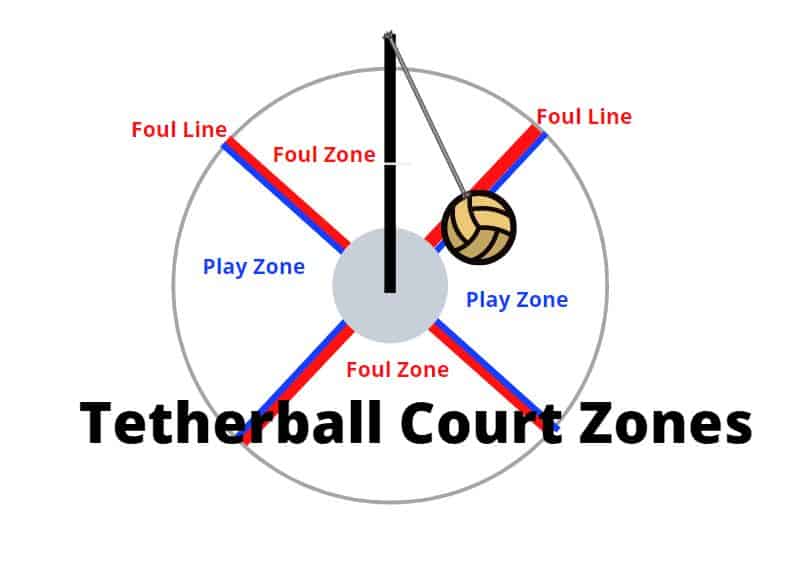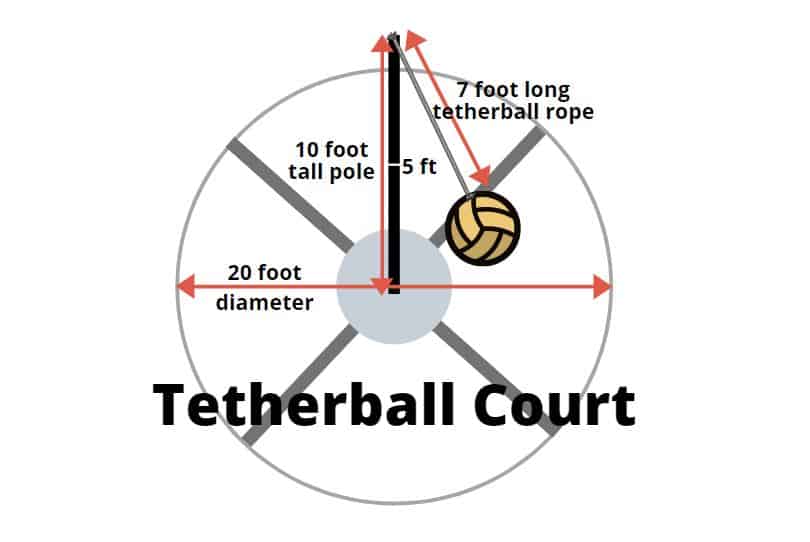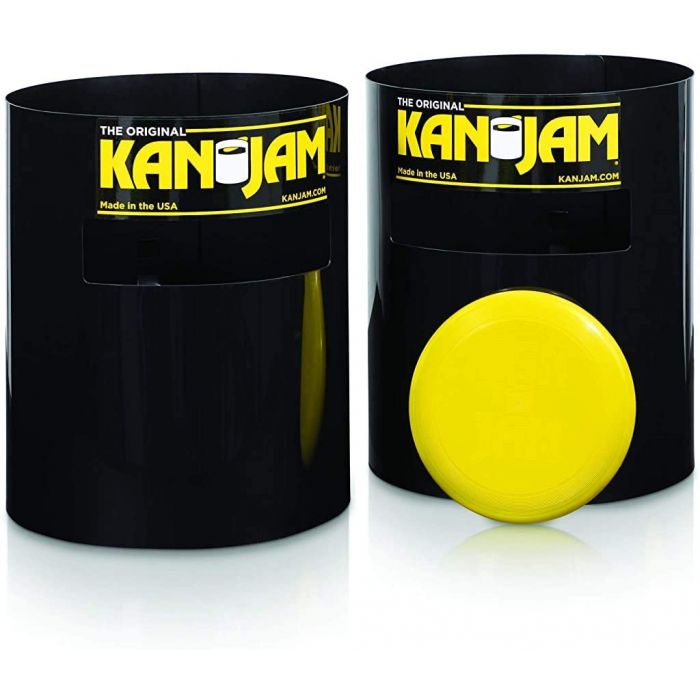QUICK SUMMARY ↬ To play tetherball, you need two players and a tetherball court. To win the game you will need to hit the tetherball past your opponent enough times that the rope will wrap around the tetherball pole. You must stay within the boundaries of the court and avoid penalties by following the rules of the game.
If you have the space for it, tetherball can be a fun addition to your backyard games. This game is low-maintenance, simple, and is a great workout.
The game is mostly played in an informal way, with many players making their own house rules. With a little know-how and an understanding of the rules, you can soon enjoy playing tetherball yourself. However, it’s best to know how to play the official tetherball game and add rules as you see fit.
How to play tetherball
To play a game of tetherball you will need two players. The two players will compete with one another to wrap the rope around the tetherball pole. One player will hit the ball clockwise around the pole and the other will hit the ball counter-clockwise.
Because the ball is attached to the pole by a rope, the rope will wrap around the pole when you hit the ball past your opponent and back around to your side of the court. You have to stay within the boundaries of the court and avoid penalties to win the game. Some penalties count as an automatic loss, but we will get into that later.
A typical game will involve both players hitting the tetherball back and forth. The goal is to try hitting the ball out of reach of the other player. This is in the hopes that your opponent will miss the ball. The ball will come back around to you, and the rope will wrap around the pole in your favor.
As the tetherball rope wraps around the pole, the rope gets shorter, increasing the difficulty of the game and the speed of the ball. When the rope has wrapped around the pole to the point where it can’t wrap around anymore, the match is over.
Here’s a video explanation to better show how the game is played.
That’s the basics of the game and how to play. But you still need to know how the court is laid out, and the rules that will cause you to incur penalties. Also, later on, we have some strategy tips to give you an edge in every game you play.
Tetherball court setup
The tetherball court setup we will go over here is the traditional backyard tetherball court setup. You can always adjust some of the heights and lengths to fit your needs. Especially if you have kids playing, they won’t have much fun on a full-size official tetherball court.
Tetherball Court Dimensions
A traditional tetherball court is a 20-foot diameter circle split into 4 sections. You may want to go with a 16-foot diameter circle if you’re setting the court up for kids. The court will mark the area of play for the tetherball game.
To split the court into 4 sections, simply draw a big ‘X’ in the middle of the court. Two of the sections will be play areas and the other two will be out of bounds or foul areas.
Some players prefer to just split the court into two sections, one for each player with no out-of-bounds area.
Here is a picture to show you the tetherball court zone layout:

Tetherball Pole Height
The pole height for a traditional tetherball court is 10 feet from the ground to the top of the pole. On a youth court, the tetherball pole height is typically 8 feet from the ground to the top of the pole. The tetherball pole is to sit perpendicular to a flat tetherball court surface.
Tetherball Rope Length
The length of a tetherball rope for a 10-foot pole is typically around 7 feet long. The rope length can vary depending on the size of the pole. The ball will traditionally sit 3 feet above the ground when hanging freely by the rope attached to the top of the pole.
You can make your own adjustments to the rope length to fit your needs. For example, If you plan on having an 8-foot pole for youths, consider making the rope about 6 feet long. This will let the tetherball hang freely just 2 feet above the ground. This seems to work a lot better for the kids, who may be struggling to play the game as it is.
Here is a helpful diagram showing the tetherball setup lengths:

Assembling A Tetherball Pole
Once you have the court laid out in a nice flat area, all you have left to do is set up the tetherball pole. Regardless if you’re making your own tetherball court, buying a portable court, or installing a permanent tetherball court, the setup of the rope and tetherball are basically the same.
- Inflate the tetherball with an air pump
- Attach the ball to the tetherball rope (if it doesn’t come already attached)
- Hook the other end of the tetherball rope to the top of the pole (the pole will usually have an eyelet or carabiner to attach)
- Fill the base with sand or water (if using a portable base)
Be careful with the cheaper poles and tetherball kits, they tend to last less than a year.
If you plan on installing a permanent tetherball pole, the kit will typically come with a 12-foot pole. You are supposed to have 2 feet of the pole buried in the ground so that you end up with a 10 feet tetherball pole from ground height to the top of the pole.
How to start playing tetherball
You know the basics of the game, how to set up the court, and how to set up the pole. It’s time to actually start playing.
To start a game, one player will serve the ball to the other player. How you decide who serves first is up to you. Some people like to flip a coin or play rock, paper, scissors.
Others like to hold the ball over a foul line and let it go. After the ball hits the pole, whichever side the ball bounces to will be the first server. Usually whoever wins the first round will be the server for the next round and so on. The server will wrap the tether around the pole one time in the opposite direction of the service before they start the game.
Now that you know how to start a game, you need to know what can end a game besides wrapping the rope around the pole all the way.

Standard Tetherball rules
The rules of tetherball are simple, but added house rules can make the game more interesting and fun. Typically there will be a list of fouls. If a player commits a foul, they automatically lose that match. Here is a list of traditional tetherball fouls.
Tetherball Rules:
- Ball can only be hit with hand or forearm
- Ball or rope cannot be held or caught
- Players must stay within play area
- Players cannot touch the pole
- Players cannot hit the ball outside the play area
- Any foul is an automatic loss
We’ve created a printout of this rule list with an area to add house rules you may think of as you go. We like to put this up somewhere near the tetherball court as a reference in case there is ever a disagreement about which rules of the game we’re following.

Double Foul
If two players commit a foul at the same time, the match can’t be given to either player. Instead, the match will start over with the original server serving the ball again. An interesting alternative to this is a house rule, where both players will stand with one hand on the ball and let the ball drop. After the ball hits the pole, the ball is back in play and the game continues.
House Rules
This is where you can make the game interesting. A lot of backyard tetherball players will make their own house rules. It comes with the territory, you’re playing on someone’s court, you have to follow their house rules. Here are some house rules to consider:
- Court only has two sides, there is no foul area
- Double hitting the tetherball on your side is allowed
- Crossing to your opponents side of the court does not result in a loss. Instead, the opponent now gets to serve the ball.
- You may hit the ball with any body part
- Ball may be held for 2 Mississippi (good for kids learning to play)
- Win by 2 points
Pick and choose from this list, or create your own house rules! This game is all about having fun.
Tetherball scoring
Typically a tetherball game consists of 7 matches each worth a point. The first person who wins 4 matches wins the game. A player wins a point by wrapping the tetherball rope around the pole as far as it will go. A player can also win a match when their opponent commits a foul.
Any foul from the rules section above is an automatic loss of the match and a point to the winner. Some house rules may require a game to be won by the 2 points. If the score is tied at 3 points, the next match does not decide the winner, instead, the winner would need to have 5 points to win the game. This can cause the game to drag out a bit but makes for an intense game ending.

Tetherball strategy
You will no doubt get better at tetherball the more you play, but there are some strategies you could implement to win every time. Ok, maybe not every time, but these tips will give you an edge against your opponent.
Hand Placement
Hitting with an open palm or closed fist will give you vastly different results. Using your open palm to hit the ball will give you more control over where the ball goes. On the other hand, hitting the ball with a closed fist will give you a lot more power.
Try to not hit the ball with your knuckles on a closed fist hit. Doing so could cause the ball to swing wildly off course. Instead, hit the ball with the side of your closed fist for maximum power and accuracy.
Keep Them Guessing
You can try to fake out your opponent by seeming like you are going for a power move super slam hit, causing them to back up or change position, then you just tap the ball lightly or vice versa.
The goal is to get the ball past your opponent and back around the pole to you as many times in a row as possible, so a little trickery could help you.
Keep light on your feet, your opponent may pick up on this tactic and try to use it against you. The only difference is, you can be ready for it. Keep your opponent guessing to maintain the upper hand throughout the game.
Angle Change Up
Switch up the angle you hit the ball with. You will need to work on your hand-eye coordination to get good at this tactic, but is one of the most valuable skills in the game.
Keep track of where your opponent is on the court and plan the angle you will hit the ball at.
Striking the ball with force at a downward angle could propel the ball up and over its head. If your opponent can’t reach the ball, they can’t return it to you, giving you a wrap around the pole.
Sometimes you can get into a rhythm doing this, keeping the ball on the same trajectory to rack up a couple of wraps around the pole in a row.
FAQs about Tetherball?
Can I swing the ball by the top?
Not unless you make it a house rule. That would be called carrying, and that is a penalty.
Am I allowed to hit the ball?
The point of tetherball is to hit the ball and not miss, so yes you do hit the tetherball.
Is it okay if my school has its own certain rules for playing?
Yes, for safety issues they will probably do that. You just have to find a way to adapt that and work around those rules.
Does the newcomer serve?
There is no set order. Players will usually take turns serving.
Who serves the ball at the beginning of tetherball?
You can ask someone who isn’t playing at the moment to stand at the halfway point in between each side, holding the ball. They drop the ball, it hits the pole, and whoever’s side it bounces onto gets to start hitting the ball.
What type of ball is used in tetherball?
Preferably the size and weight of a volleyball, but is somewhat firmer unless a soft tetherball is specifically purchased.
How tall is the pole in tetherball?
The pole is often 10 feet (3.0 m) high and can be as low as 7 feet (2.1 m) high depending upon the height of the players.
How do I hit the tetherball hard?
You can hit it will your fist and it will hit hard. It might hurt your hands at first but calluses will grow and it will no longer hurt.
